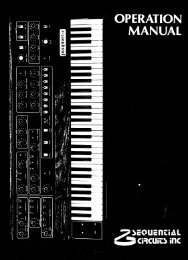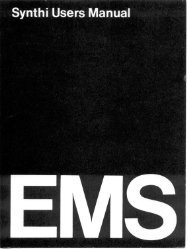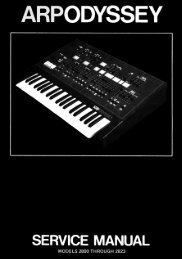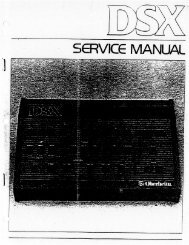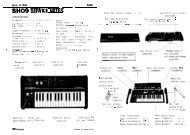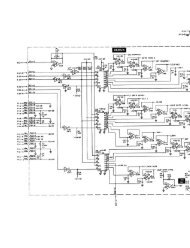ARP2600 - Fundamentals of Music Technology - Cyborgstudio.com
ARP2600 - Fundamentals of Music Technology - Cyborgstudio.com
ARP2600 - Fundamentals of Music Technology - Cyborgstudio.com
You also want an ePaper? Increase the reach of your titles
YUMPU automatically turns print PDFs into web optimized ePapers that Google loves.
050 - SECTION SIX: VCFTHE ROLE OF THE FILTER IN THE SYNTHESIZERIt is important to realize that filters are not a ‘set and forget’ module <strong>of</strong> a synthesizer. Although there aretimes when their Fc is set and left at a particular frequency, most <strong>of</strong> the time, the Fc will be constantlychanged via modulation. This constant change is what brings the sound to life and makes the soundinteresting. There is nothing more deadly than a synthesizer sound that does not change. Some musiciansthink that they can make up for incredibly dull sounds by playing lots <strong>of</strong> interesting notes, butwhen it <strong>com</strong>es to synthesizers, the notes that are being played are only half <strong>of</strong> the music being produced.In the world <strong>of</strong> synthesizers, the sound itself is as important as the music being played.USING THE VCF AS A MIXERIn addition to control sliders for cut<strong>of</strong>f frequency, fine tuning <strong>of</strong> Fc, and resonance amount, a physicalsurvey <strong>of</strong> the VCF will reveal that it is blessed with eight inputs. The three inputs on the right side arecontrol inputs and the left five inputs are audio inputs. These inputs allow signals to be input to thefilter so that they can be filtered and passed out the filter’s output (right hand side <strong>of</strong> the filter). It isinteresting to note that signals move left to right even within different synthesizer modules.There are many inputs on the filter so that many different signals can be fed to the filter for filtering atonce. However, the synthesist can use this feature to his/her advantage by using the filter to mix severalsounds together. All <strong>of</strong> the audio inputs have a slider above them which allows the user to control thevolume level <strong>of</strong> each signal being input. The inputs are mixed together, filtered, and appear at thefilter’s output.Notice also that each <strong>of</strong> the filter’s audio inputs is normalled to the output <strong>of</strong> a different module. One isnormalled to each <strong>of</strong> the VCO’s, one to the noise generator’s output, and the final one to a module yetto be discovered. Thus, another piece <strong>of</strong> the puzzle has been filled in for us. The most basic patch startswith oscillators and possibly the noise generator, all <strong>of</strong> which is then fed to the filter.THE VCF IN PRACTICEUp to this point, this section has dealt with raw factual information about filters, their types, how theywork, etc. However, nothing has been said about how they are <strong>com</strong>monly used in synthesis applications.Generally, the outputs <strong>of</strong> the oscillators (and sometimes the noise generator) will be routed to theaudio inputs on the filter (note that they are already normalled there). Notice that there is an attenuationslider above each <strong>of</strong> the audio inputs. This allows a user to control the volume <strong>of</strong> each in<strong>com</strong>ing signal.Thus, the filter is a very useful tool for mixing sounds together. When a little resonance is added, andthe filter’s Fc is swept up and/or down, an effect called a filter sweep is created, which is one <strong>of</strong> themost <strong>com</strong>monly used filtered sounds today.Another way in which the filter is extremely helpful is that it can stop the constant monotonous output<strong>of</strong> the oscillators. Of course, the oscillators continue to oscillate no matter what they are connected to.However, when the filter’s Fc is set low enough, it can stop all sound <strong>com</strong>ing through the filter. Whenthe device in the next section is explored (the envelope generator), the process <strong>of</strong> automating the changein Fc will be explained.




